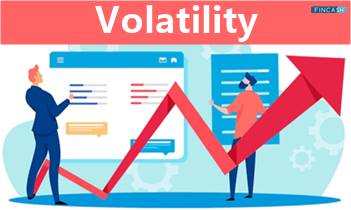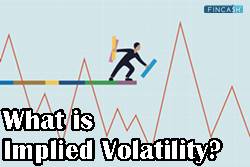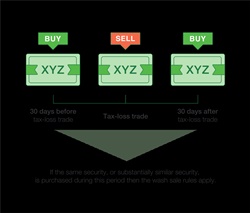Defining Volatility
Volatility refers to the statistical measure of the return dispersion of a security or Market index. It describes the level of risk or uncertainty associated with the size of variations in a security's value.
Lower volatility indicates that the value of security doesn't fluctuate dramatically and is more stable. As volatility boosts, the security gets riskier in most circumstances. The Standard Deviation or variation in returns is frequently used to measure volatility.

It is often connected with larger swings in the securities markets. A "volatile" market is where the stock market rises and falls by more than 1% over a long period. This piece contains a brief guide on volatility, the formula to calculate it, and how to deal with it.
Historical vs Implied Volatility
An essential measure for options traders is Implied volatility, also known as predicted volatility. It helps them predict the volatility level of the market in the future. Traders can use this concept to evaluate probability. One thing to remember is that it cannot predict how the market will move in the future.
Implied volatility is derived from the price of a given option and represents future volatility predictions. Traders should not use previous performance to predict the outcomes of future performance. Instead of it, they must calculate the market potential for that option. Historical volatility, also known as statistical volatility, measures price movements across predetermined periods to analyse the fluctuations of Underlying securities. It is a less popular statistic as compared to the implied volatility.
As the historical volatility increases, the price of an investment moves more than usual. On the other side, if historical volatility decreases, it suggests that any ambiguity has been removed, and things have returned to normal. This computation can be based on intraday changes, even though comparing swings between closing prices is more common. Historical volatility can be calculated in increments ranging from 10 to 180 trading days, depending on the length of the options contract.
Talk to our investment specialist
Causes of Volatility
Volatility rises due to a variety of factors, including:
Politics and Economics
When it comes to trade agreements, laws, policies, etc., the government has a significant role in regulating sectors and can hugely impact the Economy. Everything, including speeches and elections, can elicit reactions from investors, affecting stock prices. Economic data is also important because investors are more likely to respond positively when the economy is doing well. Monthly job reports can influence market performance, Inflation data, consumer spending figures, and quarterly GDP calculations. On the other hand, if these fall short of market expectations, markets can become more volatile.
Industry and Sector
Volatility in an Industry or sector can get triggered by certain occurrences. A significant weather event in a larger oil-producing region might cause oil prices to rise in the oil industry. Thus, oil distribution-related firms' stock prices rise as they are likely to benefit. However, those with significant oil costs may see their stock prices decline. Similarly, higher government regulation in a particular industry can cause stock prices to decline due to increased compliance and personnel costs, influencing future Earnings growth.
Company's Success
Volatility isn't always market-wide; it might also be specific to a single company. Positive news, such as a solid Earnings Report or a new product impressing customers, can boost investor confidence in the company. If many investors are interested in purchasing it, the greater demand can drive the share price. A product recall, bad management behaviour, or data breach, on the other hand, can cause investors to sell their stock. This favourable or poor performance might impact the larger market, depending on the size of the company.
Calculating Volatility
Calculation of the standard deviation of a security's prices over time is the most straightforward way to determine its volatility. This can be accomplished by following the steps below:
- Compile a list of the security's previous prices
- Find out the average (mean) price of the security's previous prices
- Evaluate the difference between each of the set's prices and the average
- Differences from the previous step have to be squared
- Add the squared differences
- Divide the total quantity of prices in the collection by the squared differences to find the variance
- Calculate the square root of the resultant
Example of Volatility
Suppose you want to know how volatile ABC Corp.'s stock has been in the last four days. The following are the stock prices:
| Day | Amount |
|---|---|
| 1 | Rs. 11 |
| 2 | Rs. 12 |
| 3 | Rs. 8 |
| 4 | Rs. 14 |
For calculating the volatility of prices,
Average price = (Rs. 11 + Rs. 12 + Rs. 8 + Rs. 14 )/4 = Rs. 11.25
Difference between each actual price and average price:
| Day | Difference |
|---|---|
| 1 | Rs. 11 - Rs. 11.25 = Rs. -0.25 |
| 2 | Rs. 12 - Rs. 11.25 = Rs. 0.75 |
| 3 | Rs. 8 – Rs. 11.25 = Rs. -3.25 |
| 4 | Rs. 14 – Rs. 11.25 = Rs. 2.75 |
Squaring these differences:
| Day | Squared Resultant |
|---|---|
| 1 | 0.0625 |
| 2 | 0.56 |
| 3 | 10.562 |
| 4 | 7.56 |
Summing the squared results: 0.0625 + 0.56 + 10.56 + 7.56 = 18.75
Finding the variance: 18.75 / 4 = 4.687
Finding standard deviation = Rs. 2.164
According to the standard deviation, ABC Corp.'s stock price typically deviates by Rs. 2.164 from its average stock price.
Normal Market Volatility Level
Markets are subjected to instances of regularly increased volatility. Being an investor, you must expect around 15% fluctuation from average returns over a year. The stock market is also tranquil for the most part, with brief episodes of market volatility that are above average.
Stock prices are not always bouncing around. There are extended stretches of smaller movement, followed by brief spikes in any direction. Such events cause average volatility to be higher than on most days. Bullish (upward-trending) markets are popular for their low volatility, whereas bearish (downward-trending) are known for their unpredictable price movements, which are frequently downward.
Handling Market Volatility
There are many ways to respond to your Portfolio's ups and downs. But one thing is certain frantic selling following a significant market collapse is not advised. If you ever got out at the bottom and waited to get back in, your assets would miss out on huge rebounds and may never regain the value they lost. Instead, if market volatility makes you nervous, adopt one of the following strategies:
Remember your Long-Term Strategy:
Investing is a long-term game, and a well-balanced, diversified portfolio was designed just for periods like this. If you need money sooner, don't put it in the market where volatility can make it tough to get it out any time earlier. However, volatility is an essential aspect of achieving big growth in the long run.
Take Advantage of Market Volatility:
Consider the amount of stock you can buy while the market is in a bearish trend to assist you in mentally coping with the notion of market volatility.
Maintain a Healthy Emergency Fund:
Market volatility isn't an issue unless you need to liquidate an investment in an emergency. In such a situation, you may be forced to sell assets in a down market. Investors are required to have an emergency reserve of three to six months' worth of living expenses. financial advisors also recommend putting aside up to 2 years' worth of non-market associated assets if you're nearing retirement. Cash, Bonds, cash values in Life Insurance, home equity lines of credit, and home equity conversion mortgages all fall into this category.
Rebalance Your Portfolio:
Since market volatility can produce abrupt changes in investment values, your Asset Allocation may stray from desired divisions following a period of extreme volatility in either direction. It would assist if you rebalanced your portfolio during these periods to align with your investing goals and match the required risk level. When you rebalance, sell one Asset Class that has grown too large in your portfolio and use the proceeds for buying more of the asset class that has shrunk too much.
It's time to rebalance when your allocation deviates by more than 5% from your original intended mix. If you notice a more than 20% variation in an asset class, you would want to rebalance.
Volatility Characterising Long-term Investing
Changes in commerce, politics, economic outcomes, and business actions are all factors that can agitate markets while generating volatility. Investors prepared for times of volatility from the beginning of their investing journey are not much surprised when they occur and are more likely to react rationally. In this situation, you should prepare yourself and stay focused on your long-term Financial goals by adopting a mindset that accepts volatility as a natural element of investing. Market volatility is highly common, and it is also understandable to be anxious. Finally, remember that market volatility is a normal component of investing, and the firms you invest in will react to a crisis.
Conclusion
Market corrections can sometimes create entry positions from which investors can profit, so volatility isn't always bad. A market correction can present a chance for an investor who has funds and is waiting to invest in the stock market at a lower price. Investors who feel markets will perform well, in the long run, might take advantage of lower market volatility by purchasing additional shares in firms they like at lower prices. Investors who get the idea of the volatility and its causes may take advantage of the investment possibilities it presents to achieve higher long-term profits.
All efforts have been made to ensure the information provided here is accurate. However, no guarantees are made regarding correctness of data. Please verify with scheme information document before making any investment.












